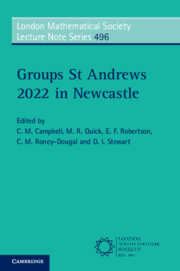Book contents
- Frontmatter
- Contents
- Introduction
- 1 Finite group schemes
- 2 Algorithms for polycyclic groups
- 3 The spread of finite and infinite groups
- 4 Discrete subgroups of semisimple Lie groups, beyond lattices
- 5 Complete reducibility and subgroups of exceptional algebraic groups
- 6 Axial algebras of Jordan and Monster type
- 7 An introduction to the local-to-global behaviour of groups acting on trees and the theory of local action diagrams
- 8 Finite groups and the class-size prime graph revisited
- 9 Character bounds for finite simple groups and applications
- 10 Generalized Baumslag-Solitar groups: a topological approach
- References
9 - Character bounds for finite simple groups and applications
Published online by Cambridge University Press: 21 November 2024
- Frontmatter
- Contents
- Introduction
- 1 Finite group schemes
- 2 Algorithms for polycyclic groups
- 3 The spread of finite and infinite groups
- 4 Discrete subgroups of semisimple Lie groups, beyond lattices
- 5 Complete reducibility and subgroups of exceptional algebraic groups
- 6 Axial algebras of Jordan and Monster type
- 7 An introduction to the local-to-global behaviour of groups acting on trees and the theory of local action diagrams
- 8 Finite groups and the class-size prime graph revisited
- 9 Character bounds for finite simple groups and applications
- 10 Generalized Baumslag-Solitar groups: a topological approach
- References
Summary
Given the current knowledge of complex representations of finite quasi-simple groups, obtaining good upper bounds for their characters values still remains a difficult problem, a satisfactory solution of which would have significant implications in a number of applications. We will report on recent results that produce such character bounds, and discuss some such applications, in and outside of group theory.
Information
- Type
- Chapter
- Information
- Groups St Andrews 2022 in Newcastle , pp. 360 - 406Publisher: Cambridge University PressPrint publication year: 2024
